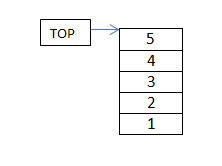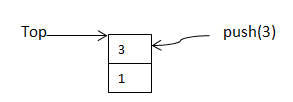

C++中的标准容器类 stack 和 queue 使用实例剖析,非常简单的实例demo,stack 和 queu...
source link: https://blog.popkx.com/examples-analysis-of-stack-and-queue-in-C-STL/
Go to the source link to view the article. You can view the picture content, updated content and better typesetting reading experience. If the link is broken, please click the button below to view the snapshot at that time.
C++中的标准容器类 stack 和 queue 使用实例剖析,非常简单的实例demo,stack 和 queue 容器的头文件
stack 容器
C++ STL 中的 stack 容器是一种容器适配器(container adaptor),可以用来在 C++ 程序中复制堆栈数据结构,和编程语言概念中的常规堆栈数据结构类似,stack 容器也是“后进先出”,元素从一端被插入,也在同一端被删除,该端通常被称作“栈顶”。
如上图所示,stack 容器内最先被插入的元素,只能在最后被删除。
如果希望使用 stack 容器,需要在代码中包含头文件:
#include <stack>一般来说,定义一个 stack 容器对象的语法如下:
stack<obj type> stackName;stack 容器类的操作
接下来将讨论 STL 中的 stack 容器类的各种操作。
- push:push 操作用于将元素插入到 stack,正如前面讨论的,push 总是把元素插入到栈顶。
下图是一个 int 类型的 stack 容器对象 mystack:
添加元素 1 到 mystack:
然后再添加元素 3 到 mystack:
每次添加的新元素都位于栈顶位置,每次添加容器的 size 都增加 1。
- pop:pop 操作用于从 stack 容器中取出(remove)一个元素,被取出的元素位于栈顶,该操作完成后,stack 的 size 减 1。
我们的 mystack 已经包含两个元素了,如下图:
现在,我们调用 pop() 函数,正如前面介绍的,栈顶元素被取出(remove),mystack 的 size 由 2 变为 1,也即只包含一个元素了:
再调用一次 pop() 函数,仅存的元素 1 也被取出,mystack 变为一个空 stack:
- top:返回 stack 中的栈顶元素
- empty:返回 stack 是否为空
- size:返回 stack 的 size,也即 stack 中的元素数量
下面这段代码是操作C++中 stack 容器类的一个完整示例:
#include <iostream>
#include <stack>
using namespace std;
void printStack(stack <int> stk)
{
while (!stk.empty())
{
cout << '\t' << stk.top();
stk.pop();
}
cout << '\n';
}
int main ()
{
stack <int> oddstk;
oddstk.push(1);
oddstk.push(3);
oddstk.push(5);
oddstk.push(7);
oddstk.push(9);
cout << "The stack is : ";
printStack(oddstk);
cout << "\nSize of stack: " << oddstk.size();
cout << "\nTop of stack: " << oddstk.top();
cout << "\noddstk.pop() : ";
oddstk.pop();
printStack(oddstk);
cout<<"\nAnother pop(): ";
oddstk.pop();
printStack(oddstk);
return 0;
}编译并执行这段代码,输出如下:
# g++ t.cpp -std=c++11
# ./a.out
The stack is : 9 7 5 3 1
Size of stack: 5
Top of stack: 9
oddstk.pop() : 7 5 3 1
Another pop(): 5 3 1queue
queue 是STL中的另一个容器,它也非常简单和有用。queue 容器与C++中队列数据结构非常相似,正如“队列”这个名字的字面意思,和 stack 容器不同,queue 容器有两个端点——前端和后端,其中的元素遵守“先进先出”的规则,也即新来的元素被插到 queue 容器的后面,最先被插入的元素最先被使用和删除。
如果希望在C++程序中使用 queue 容器,需要包含头文件:
#include <queue>定义一个 queue 对象的代码可以如下实现:
queue<obj type> myqueue;queue 的操作
和 stack 容器一样,我们也可以使用类似的函数方法操作 queue 容器。
- push:将元素插入到 queue 尾部
- pop:从 queue 头部取出(remove)第一个元素
下面将以整型的 queue 对象为例介绍一下相关的基本操作:
queue<int> myqueue;
myqueue.push(2);上面两行C++代码定义了一个 int 型的 queue 容器对象 myqueue,并且调用了 push 方法往队列中插入了一个元素,此时 myqueue 如下图所示:
接着,我们继续调用 push 方法,添加元素 “4” 进入 myqueue,按照前面所讨论的,新来的元素将被插入到 queue 容器尾部:
现在,使用 pop 方法从 queue 中取出元素:
myqueue.pop();从上图可以看出,当调用 pop() 方法后,queue 前端的元素被取出(remove)了,这意味着第一个被插入到 queue 中的元素第一个出列。
- front:返回 queue 中第一个元素的引用
- back:返回 queue 中最后一个元素的引用
- empty:检查 queue 是否为空,也即检查 queue 中是否有元素
- size:返回 queue 的 size,也即 queue 中元素的数目。
下面这段C++代码是一段完整使用 queue 的代码:
#include <iostream>
#include <queue>
using namespace std;
void printQueue(queue <int> myqueue)
{
queue <int> secqueue = myqueue;
while (!secqueue.empty())
{
cout << '\t' << secqueue.front();
secqueue.pop();
}
cout << '\n';
}
int main()
{
queue <int> myqueue;
myqueue.push(2);
myqueue.push(4);
myqueue.push(6);
myqueue.push(8);
cout << "The queue myqueue is : ";
printQueue(myqueue);
cout << "\nmyqueue.size() : " << myqueue.size();
cout << "\nmyqueue.front() : " << myqueue.front();
cout << "\nmyqueue.back() : " << myqueue.back();
cout << "\nmyqueue.pop() : ";
myqueue.pop();
printQueue(myqueue);
return 0;
}编译并执行这段C++代码,得到的输出如下:
The queue myqueue is : 2 4 6 8
myqueue.size() : 4
myqueue.front() : 2
myqueue.back() : 8
myqueue.pop() : 4 6 8本文主要来自:https://www.softwaretestinghelp.com/stacks-and-queues-in-stl/
阅读更多: C++
Recommend
About Joyk
Aggregate valuable and interesting links.
Joyk means Joy of geeK




